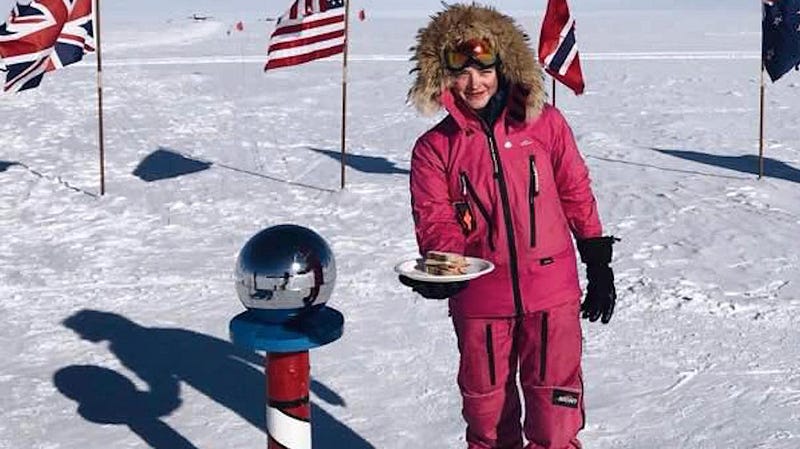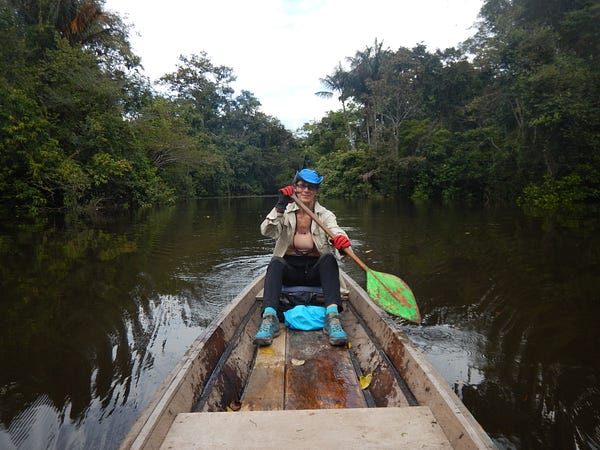
Not long ago I watched a video that Oregon Research sponsored called “Where the Wild Things Are.” The film features a few young guys hanging in a bar, complaining about the weather.
“Where are all the ladies?” One of the guys asks.
For the rest of the video, we find out. They are all over the mountains, trails, rocks, snow, blasting down steep mountains, doing a split on a line over a deep valley. Crashing, getting up doing it again. Hands wrapped in tape. Unstoppable.
A friend (in her twenties) said, quite understandably, “I love this video.”
I would too, except the producers didn’t exactly draw an accurate picture.
While I get the marketability of primarily beautiful slim young white women to sell their gear and make their point, let’s get real here.

REI’s 2017Force of Nature Campaign
As REI’s Force of Nature campaign rolled out last year as a powerful statement showing women in the outdoors, it took a very long time (September, by my watch) before I saw anyone older than perhaps thirty featured in the ads in outdoor magazines. Outside Magazine featured a woman in her sixties or seventies, her hair entangled in greenery. That’s a beginning, but frankly, I don’t look like that in the wild. I’m usually filthy, sweaty, and if I’ve got greenery in my hair, that means that my horse rode too close to the trees or there was no other way to get down the river than paddling through low branches. I do not look like an aging Lady of the Lake.

REI’s program pointed out a simple reality: most of us women don’t have female role models for epic outdoor adventures. Yet there have been plenty of them. From Isabella Bird (https://www.coloradovirtuallibrary.org/digital-colorado/colorado-histories/boom-years/isabella-bird-adventurer-and-travel-writer/) to Alexandra David-Neel (https://en.wikipedia.org/wiki/Alexandra_David-N%C3%A9el) to more recent adventurers who inspired me, such as Robyn Davidson. Davidson took three camels across the Outback in the 1970s. After I read her book in 1984, I dropped everything to go to Australia alone. I spent four years hitching, exploring, flying ultralights and scuba diving the Barrier Reef.
This is why we need role models.
We Need to See Ourselves Represented in the Wild
To their credit REI did produce wonderful videos of very athletic — NOT SLIM- powerful Black women running marathons and showing us how it’s done without looking like a starved model. They took this effort seriously. Better than most. They excoriated people who attacked these plus-sized endurance athletes. Those women would run me into the ground.
However Oregon Research’s film, like many others I’ve seen this past year, doesn’t showcase women of color or age or size.
Pardon me for stating the obvious, but we’re out there. In force.
Especially out here in Colorado.
Any time I walk into an REI or outdoors store, I am guaranteed to see plenty of very athletic women of my vintage (I’m 65) and women of size and color shopping for gear, coats, knives, crampons, gloves, beanie hats. Sleeping bags and glacier glasses and everything else you can imagine to get and keep us outside in the wild. My girl cave is stocked with adventure gear for at least six sports. I forget. I keep adding more.
It’s Just More Visible Now
It occasionally frustrates me that an entire generation seems to believe that everything they are doing is somehow new. It may be new to them, but not to women like me, and many more who preceded me. While I give every single bit of credit to those uber-athletes who are pushing the bar higher, epic women have been out there in the wild a very long time. Just because now we can see it on Instagram or social media doesn’t make it new.
Social media makes it vastly more visible.
We’ve Already Been There, Done That- And Now Raise the Bar
Women like Margo Talbot of Canada, now 53, who was among the very first female ice climbers. Everest sheroes, some now gone like Junko Tabei, who braved everything to get to the top of the world. They didn’t have cell phones to record every moment. That wasn’t the point. The point was the experience. They paved the way for all the rest of us.
I read stories about women traveling across the West solo in a pickup truck and running into a slew of obstacles. They are the same experiences I encountered thirty years ago doing precisely the same thing. Back then there was no iPhone, no cell phone. The obstacles largely haven’t changed. We have.
The good news is that social media is giving us plenty of role models who tackle these obstacles. Whether or not you like or approve of what Cheryl Strayed did in Wild, she has inspired a great many more women to give cross-hiking a shot. When Blair Braverman gives mushing in the far North a shot, she demonstrates that girls belong in the most extreme conditions.
When 16-year-old Jade Hameister skied to the South Pole, she offered all the male trolls who had been harassing her online a sandwich — if they could make it to the South Pole where she had placed it.

When women, LGBT, the disabled and older folks are suddenly far more visible in the outdoors and doing pretty epic adventures, it’s impossible to ignore them. That is what’s changed, and all for the better.
So What’s Different Today?
These young women inspire me. Watching them excel in the wild world gives me great pleasure and it’s hugely motivating. However, there’s a piece of me that would like to see both greater diversity in these depictions of “wild things,” as well as a recognition of the moms and grandmoms as well as the Nepali women who head out on Everest expeditions. Women were scrambling over rocks and climbing cracks and hurtling down snow walls long before anyone could say “cell phone.”
We’ve seen some real progress. Not only has the outdoor industry finally figured it out that girls play too, even Outside Magazine has cleaned up its act. They’ve started to feature athletic women on its cover and have backed off doing ridiculously sexy photo shoots when writing about accomplished females (as it has in the past). They review gear designed for women. They are featuring stories on early women pioneers in the wild. Why? Because we women also subscribe. And we spoke up. We are in many ways Outside’s future and they know it.
So much so that when recently, an article on sexual harassment in the outdoors got panned by a number of subscribers, Outside effectively told them not to let the door hit them on the ass on the way out. Bravo, Outside. Welcome to the 21st Century.

Women Guides and Adventure Companies are Everywhere
It’s progress. Women are even taking ownership of their bodies back through the MeToo campaign. It’s a sea change, one hopes. As women also openly take their rightful places in the wilderness as competent, trained guides, avalanche experts, and group leaders and business owners, the balance has shifted. No longer can the National Park Service tolerate years of sexual abuse and harassment of its female guides in the Grand Canyon. That ship has sailed, gentlemen.
As a consumer of adventure travel in every corner of the world, I see changes, such as the storied Tahuayo Lodge in the Peruvian Amazon that requires that women and LGBT guides WILL be supported or you lose your job. Some men complained. They lost their jobs. Tahuayo Lodge is the biggest employer for 17+ communities and pays the best wages. People paid attention. Nobody complains any more. My superbly competent guide was an extraordinary lesbian woman. She absolutely rocked. I have used a great many guides, and Neddy was as good as or better than all of them. Her gender and sexual preference had nothing to do with her competence — I only mention them here to make the point. They don’t matter. Ability matters.
Stories Change the Narrative
When I was seven, my mother gave me the book Island of the Blue Dolphins. It’s based on the true story of a Nicoleno Native American girl who got stranded for 18 years on San Nicholas Island during the 19th Century. The story of her self-sufficiency, friendships with animals and ability to survive alone struck me deeply. Stories have a way of re-framing how we see ourselves as women, as adventurers. That book was the beginning of how I veered off the typical 1960s-1970s path of marriage and kids into the Army, and a life of adventures. We need these stories, not only for ourselves but for our girls. As we begin to rediscover and celebrate past women explorers, the males-only story line disappears. We’ve always been there. In force. In nature.

We’ve Always Belonged in the Wild
When we have matured as a society to recognize that minorities, older women and those who can’t fit into sizes 2–14 are also epic adventurers, we will have earned a pat on the back. Just one. When we start making clothing and gear to fit plus size women adventures, well hallelujah. Women are getting into gear and clothing manufacturing. While it’s an uphill battle, we outdoor women are clamoring to buy clothing that fits, has pockets that reflect our work ethic and competence and not our sex (to wit, a tiny chest pocket for a chap stick? Come ON man.)
It’s coming. Been a long time, but it’s coming.
Epic women have been around since the beginning of time. It’s nice to finally start to get credit where credit is due. We’ve always belonged in the wild.
Comments powered by Talkyard.